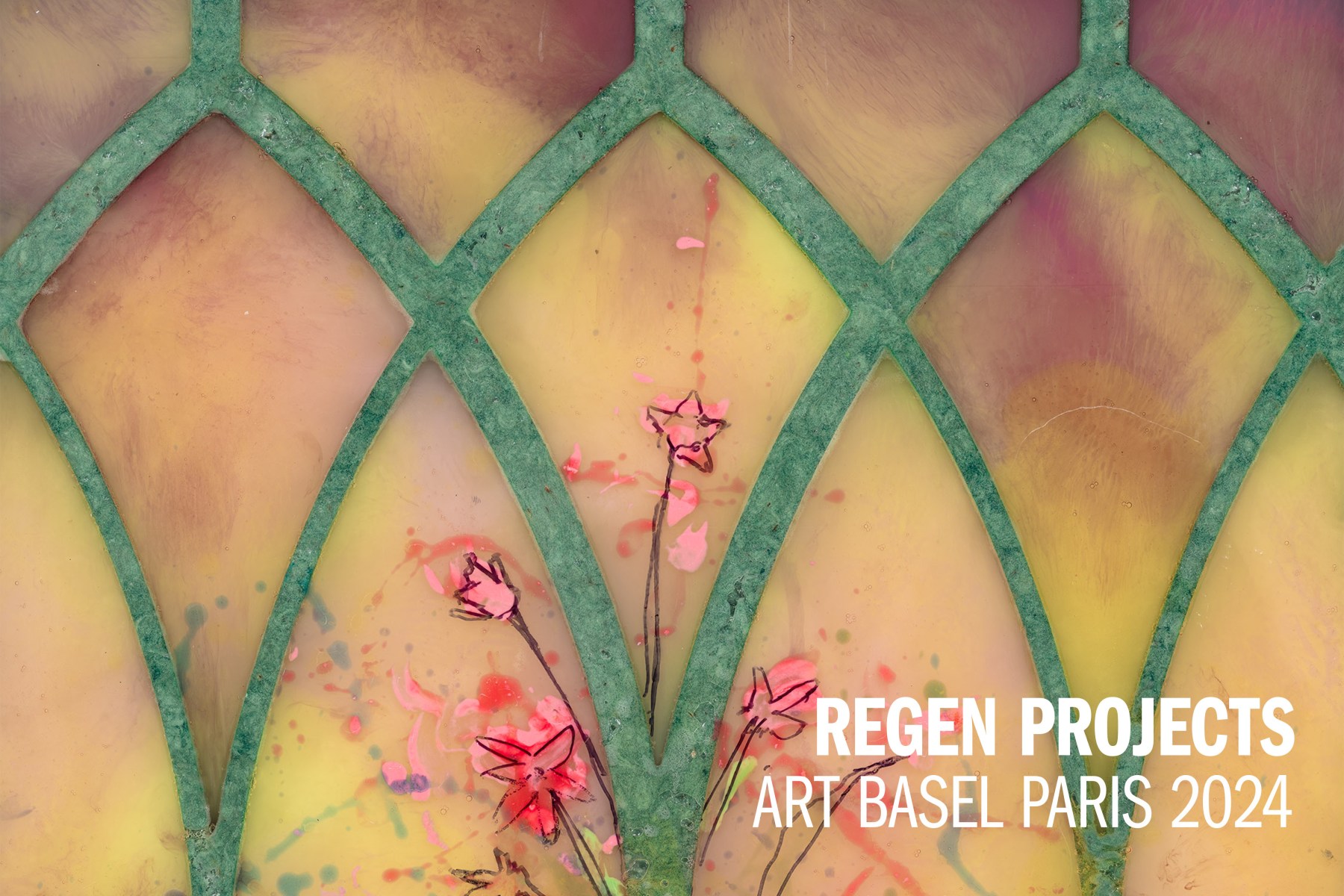
Regen Projects is pleased to participate in Art Basel 2024. This digital showcase reflects highlights from the gallery's in-person presentation, which brings together outstanding artworks representing the diverse media, styles, and techniques employed by the gallery's artists.
Featured artists include Kader Attia, Matthew Barney, Kevin Beasley, Walead Beshty, Abraham Cruzvillegas, Rachel Harrison, Alex Hubbard, Elliott Hundley, Anish Kapoor, Liz Larner, Marilyn Minter, Rebecca Morris, Aliza Nisenbaum, Catherine Opie, Silke Otto-Knapp, Raymond Pettibon, Jack Pierson, Daniel Richter, Sable Elyse Smith, Wolfgang Tillmans, Gillian Wearing, James Welling, Alberta Whittle, Sue Williams, and Andrea Zittel, among others.
Dates:
October 16 – 20, 2024
Address:
Miami Beach Convention Center
1901 Convention Center Drive
Miami Beach, FL 33139
Booth:
E23
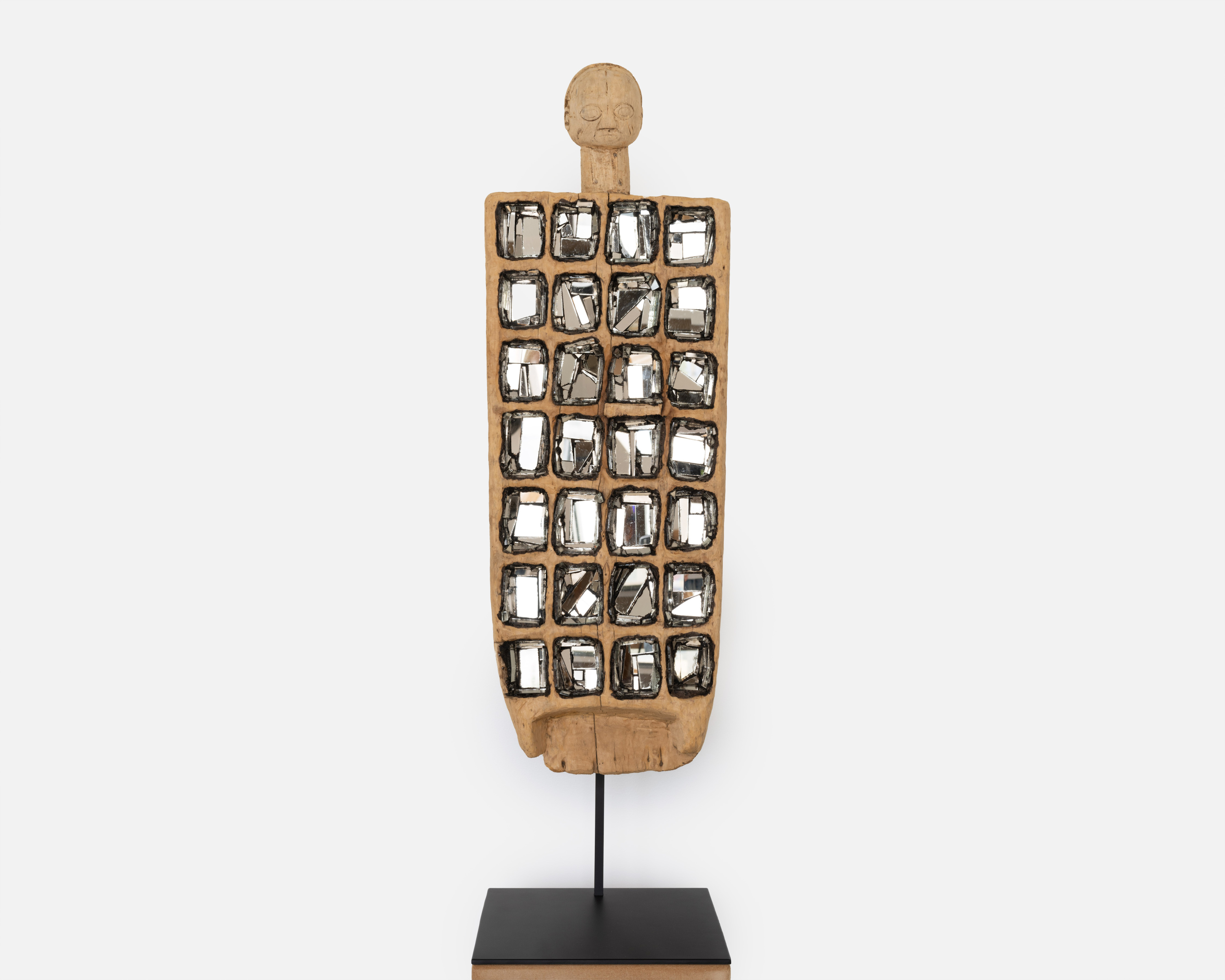
Kader Attia
Reenactment (Ngola)
2024
Wood, glue, pigments and mirrors
30 3/4 x 10 5/8 x 5 1/8 inches (78 x 27 x 13 cm)
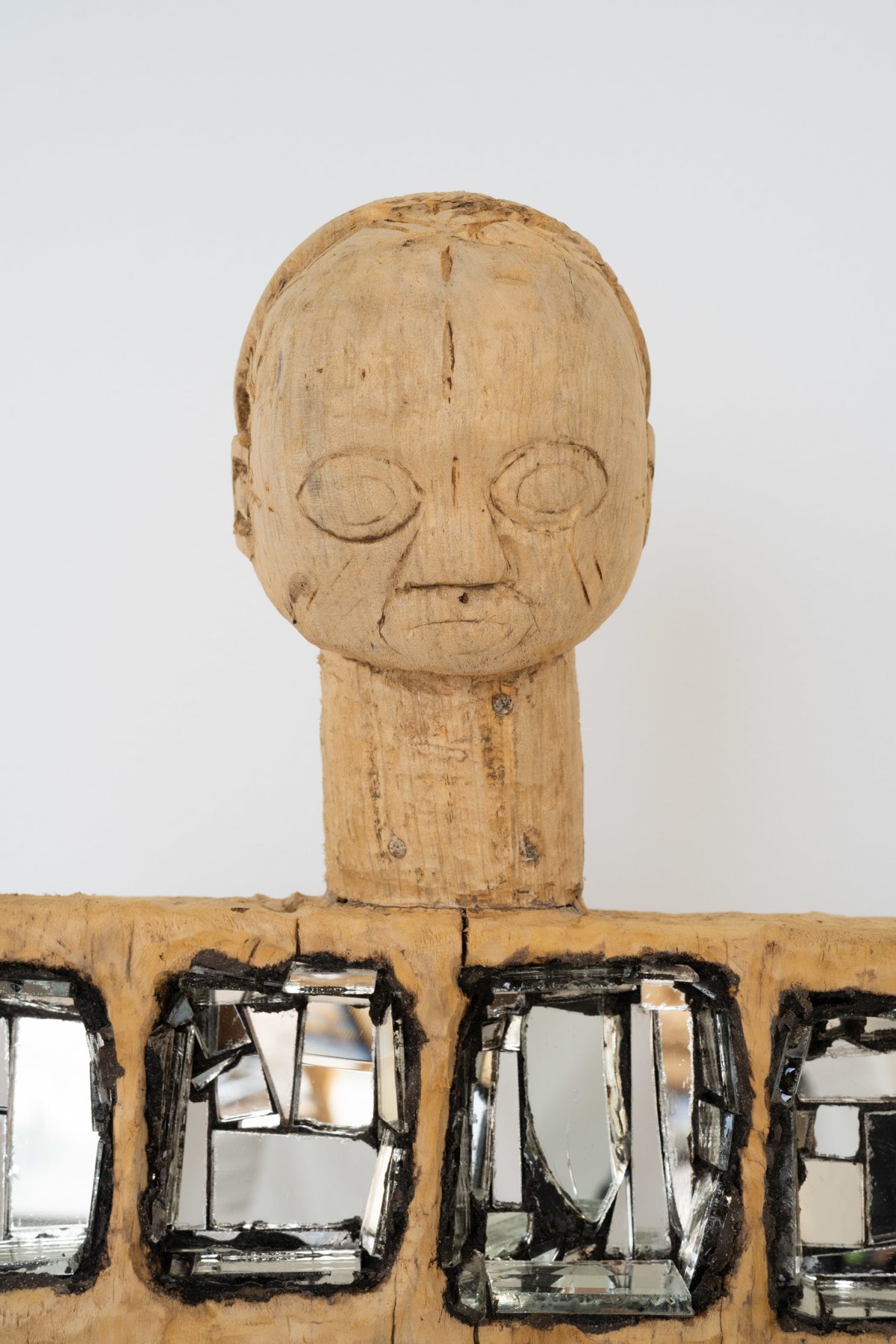
Kader Attia
Reenactment (Ngola) [detail]
2024
Wood, glue, pigments and mirrors
30 3/4 x 10 5/8 x 5 1/8 inches (78 x 27 x 13 cm)
Kader Attia (b. 1970, Dugny, France; lives and works in Berlin and Paris) was born in Paris and raised between France and Algeria. His rigorous, research-based works draw from his experience of living within two cultures to examine the lasting and wide-ranging effects of Western colonial hegemony on non-Western cultures. “Repair” often appears in Attia’s work as an important theme, as he explains it, “repair is an oxymoron, because ‘injury’ is its raison d’être. One cannot think about repairing something that hasn’t been injured. The state of the injured thing (the failure) and the state of the repaired thing (the repair) are forever bound in a causal layout that runs in the ethical and aesthetic loop of repair. This is true for all metaphors of repair: natural, cultural, political, immaterial, and so on…”
Attia’s sculpture, Reenactment (Ngola), 2024, presents the latest in his ongoing series of works related to traditional African tribal masks. While maintaining mask elements from Attia’s previous works, this sculpture marks a distinct departure in form. Based on a Central African version of the Arabic game “mancala,” Attia has distributed fragmented mirrors across the surface of the sculpture in order to equally fragment the viewer’s reflection staring back at them. Just as Cubist portraits distorted and disturbed the reality of their day, so Attia’s sculpture provides a reflection of reality that does not properly square with normative perspectives, and gives the viewer a moment of involvement to pause and reflect anew.
Kader Attia’s work has been the subject of solo exhibitions at MO.CO. Montpellier Contemporain, Montpellier (2024); Berlinische Galerie, Berlin (2024); Mathaf: Arab Museum of Modern Art, Doha (2022); BAK, basis voor actuele kunst, Utrecht (2021); Sesc Pompeia, São Paulo (2020); Kunsthaus Zürich, Zurich (2020); Berkeley Art Museum & Pacific Film Archive, Berkeley (2019); Hayward Gallery, London (2019); Palais de Tokyo, Paris (2018); The Power Plant, Toronto (2018); Centre George Pompidou, Paris (2016); Museum für Moderne Kunst, Frankfurt (2016); Musée d’Art Moderne de la Ville de Paris, Paris (2012); among others.
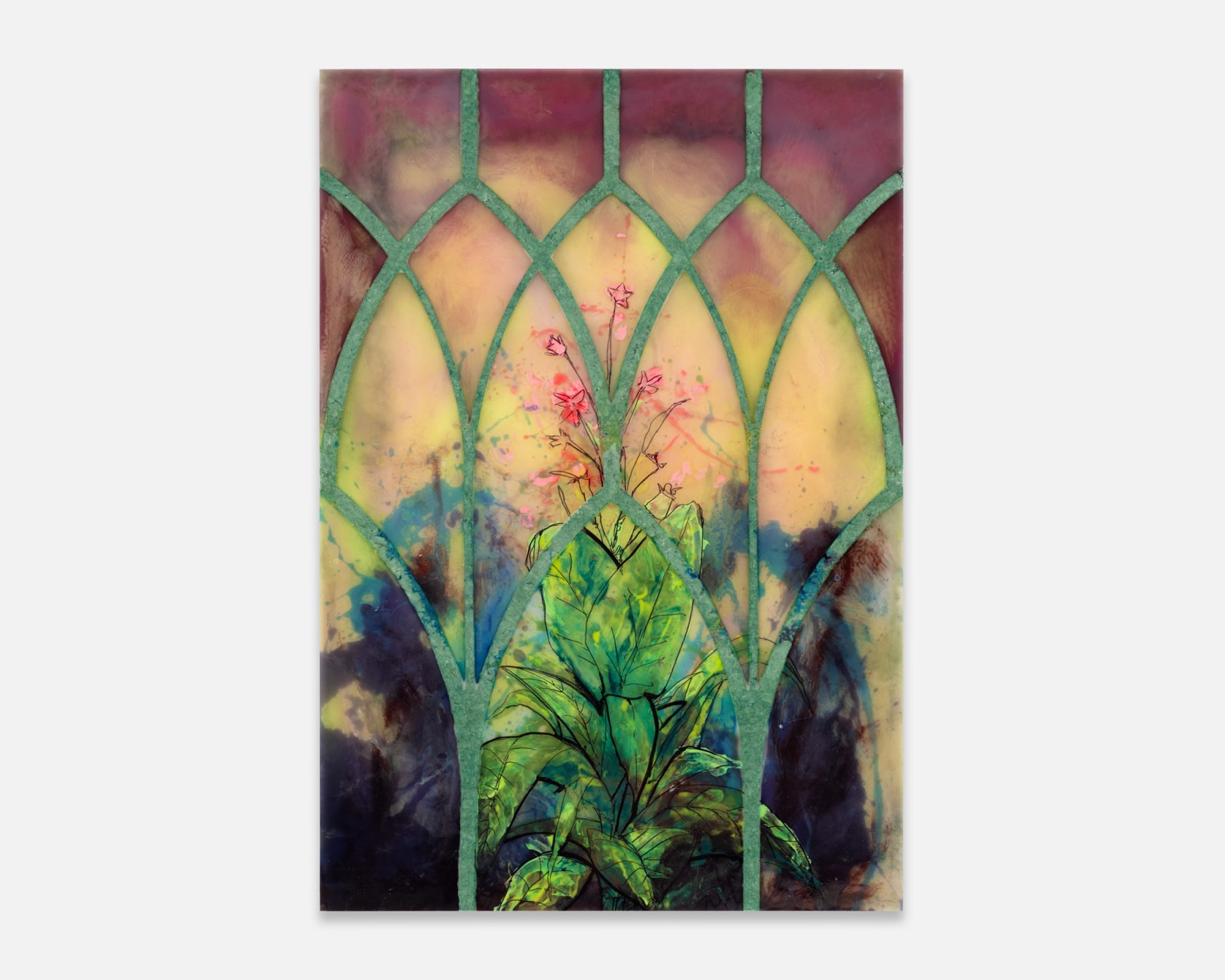
Kevin Beasley
Garden Arches VI
2024
Raw Virginia cotton, polyurethane resin, Sharpie transfer, fiberglass
51 1/2 x 35 3/4 x 1 3/8 inches (130.8 x 90.8 x 3.5 cm)
Beasley’s practice is deeply invested in drawing out the histories latent in everyday materials and connecting these pasts to the present cultural landscape. This interest manifests in works that are produced by subjecting historically charged materials to transformative processes, reconfiguring and recontextualizing them to make new meaning. Harnessing the personal, cultural, and political associations of objects, Beasley investigates the history of power and race in America.
In “slab” sculptures like Garden Arches VI, 2024, Beasley freezes the adaptive, tensile strength of familiar materials such as raw Virginia cotton in a fixed resin structure. Despite their rigidity, the surfaces retain the organic, flowing appearance of a rippling body of water or a flag caught in a breeze. By transforming quotidian materials into novel, beautiful objects, Beasley draws attention to the personal and political histories that frame daily life. Further exploring the notion of landscape - constructions that reside just outside of our view, Beasley states “I’ve never had a garden view outside my window, only the wooded backyard growing up in Virginia. Thinking of what it means to construct a natural environment around us, I find it curious and paramount to giving space to self-reflection and tending to one’s well-being.”
Beasley’s work is currently on view in Pansori - a soundscape of the 21st century, the 15th Gwangju Biennale, at the Gwangju Museum of Art, through December 1, 2024. A selection of recent exhibitions and performances include A body, revealed, Hill Art Foundation, New York (2022); Prospect.5: Yesterday we said tomorrow, New Orleans (2021), in which Beasley is realizing a multiyear, site-specific project in the Lower Ninth Ward; a series of outdoor performances for the Performa 2021 Biennial, New York; a month-long residency and solo exhibition at A4 Arts Foundation, Cape Town, South Africa (2020); and ASSEMBLY, a program co-organized by Kevin Beasley, Lumi Tan, Tim Griffin, and Nicole Kaack at The Kitchen, New York (2019). Other past exhibitions include A view of a landscape, Whitney Museum of American Art, New York; Kevin Beasley, Institute of Contemporary Art, Boston (2018); Hammer Projects: Kevin Beasley, Hammer Museum, Los Angeles (2017); and inHarlem: Kevin Beasley, The Studio Museum in Harlem, New York (2016). He was recently awarded the 2023 Heinz Family Foundation Heinz Award for the Arts.
Beasley’s practice is deeply invested in drawing out the histories latent in everyday materials and connecting these pasts to the present cultural landscape. This interest manifests in works that are produced by subjecting historically charged materials to transformative processes, reconfiguring and recontextualizing them to make new meaning. Harnessing the personal, cultural, and political associations of objects, Beasley investigates the history of power and race in America.
In “slab” sculptures like Garden Arches VI, 2024, Beasley freezes the adaptive, tensile strength of familiar materials such as raw Virginia cotton in a fixed resin structure. Despite their rigidity, the surfaces retain the organic, flowing appearance of a rippling body of water or a flag caught in a breeze. By transforming quotidian materials into novel, beautiful objects, Beasley draws attention to the personal and political histories that frame daily life. Further exploring the notion of landscape - constructions that reside just outside of our view, Beasley states “I’ve never had a garden view outside my window, only the wooded backyard growing up in Virginia. Thinking of what it means to construct a natural environment around us, I find it curious and paramount to giving space to self-reflection and tending to one’s well-being.”
Beasley’s work is currently on view in Pansori - a soundscape of the 21st century, the 15th Gwangju Biennale, at the Gwangju Museum of Art, through December 1, 2024. A selection of recent exhibitions and performances include A body, revealed, Hill Art Foundation, New York (2022); Prospect.5: Yesterday we said tomorrow, New Orleans (2021), in which Beasley is realizing a multiyear, site-specific project in the Lower Ninth Ward; a series of outdoor performances for the Performa 2021 Biennial, New York; a month-long residency and solo exhibition at A4 Arts Foundation, Cape Town, South Africa (2020); and ASSEMBLY, a program co-organized by Kevin Beasley, Lumi Tan, Tim Griffin, and Nicole Kaack at The Kitchen, New York (2019). Other past exhibitions include A view of a landscape, Whitney Museum of American Art, New York; Kevin Beasley, Institute of Contemporary Art, Boston (2018); Hammer Projects: Kevin Beasley, Hammer Museum, Los Angeles (2017); and inHarlem: Kevin Beasley, The Studio Museum in Harlem, New York (2016). He was recently awarded the 2023 Heinz Family Foundation Heinz Award for the Arts.
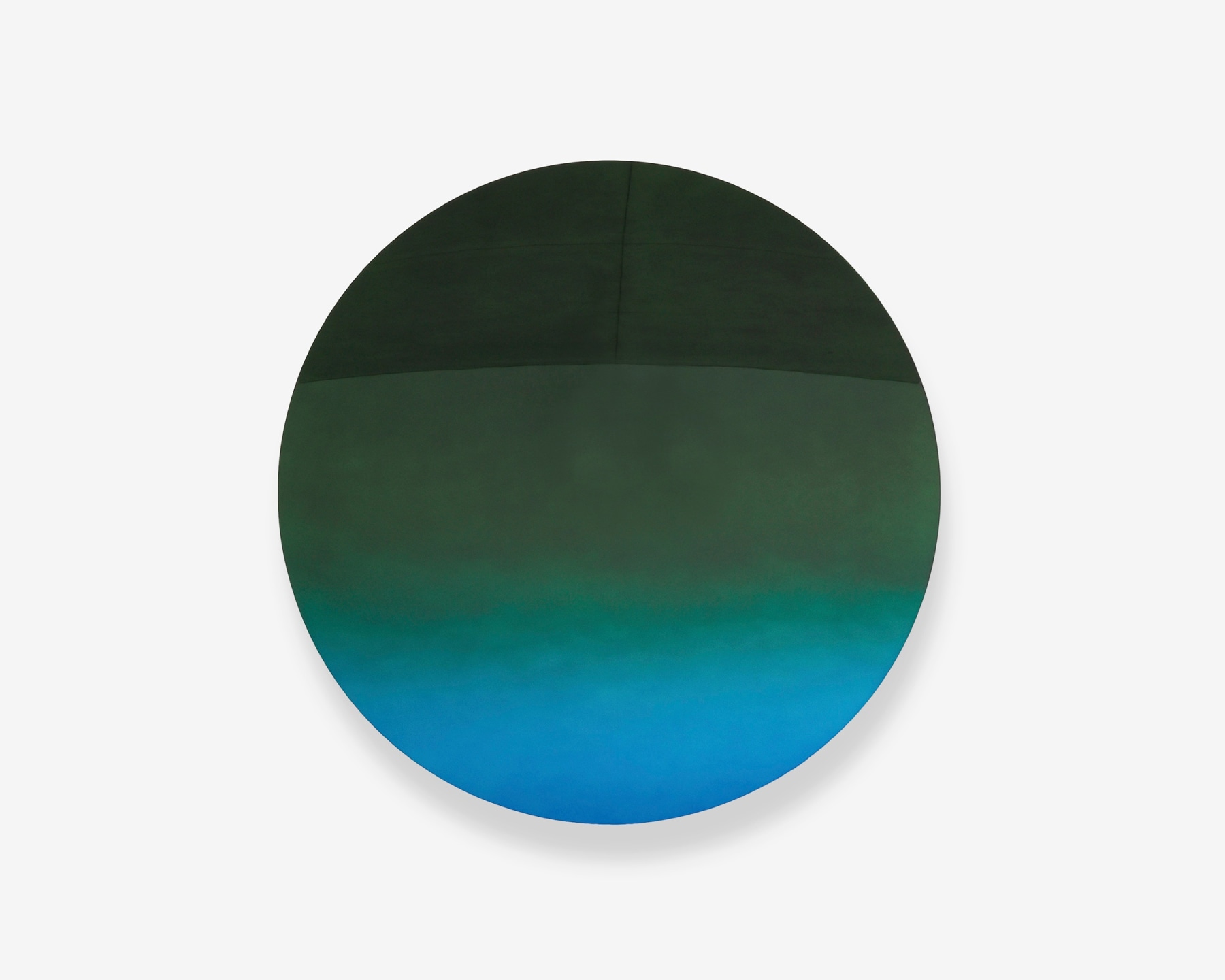
Anish Kapoor
Organic Green and Black to Oriental Blue
2023
Stainless steel, lacquer
35 3/8 x 35 3/8 x 4 inches (90 x 90 x 10 cm)
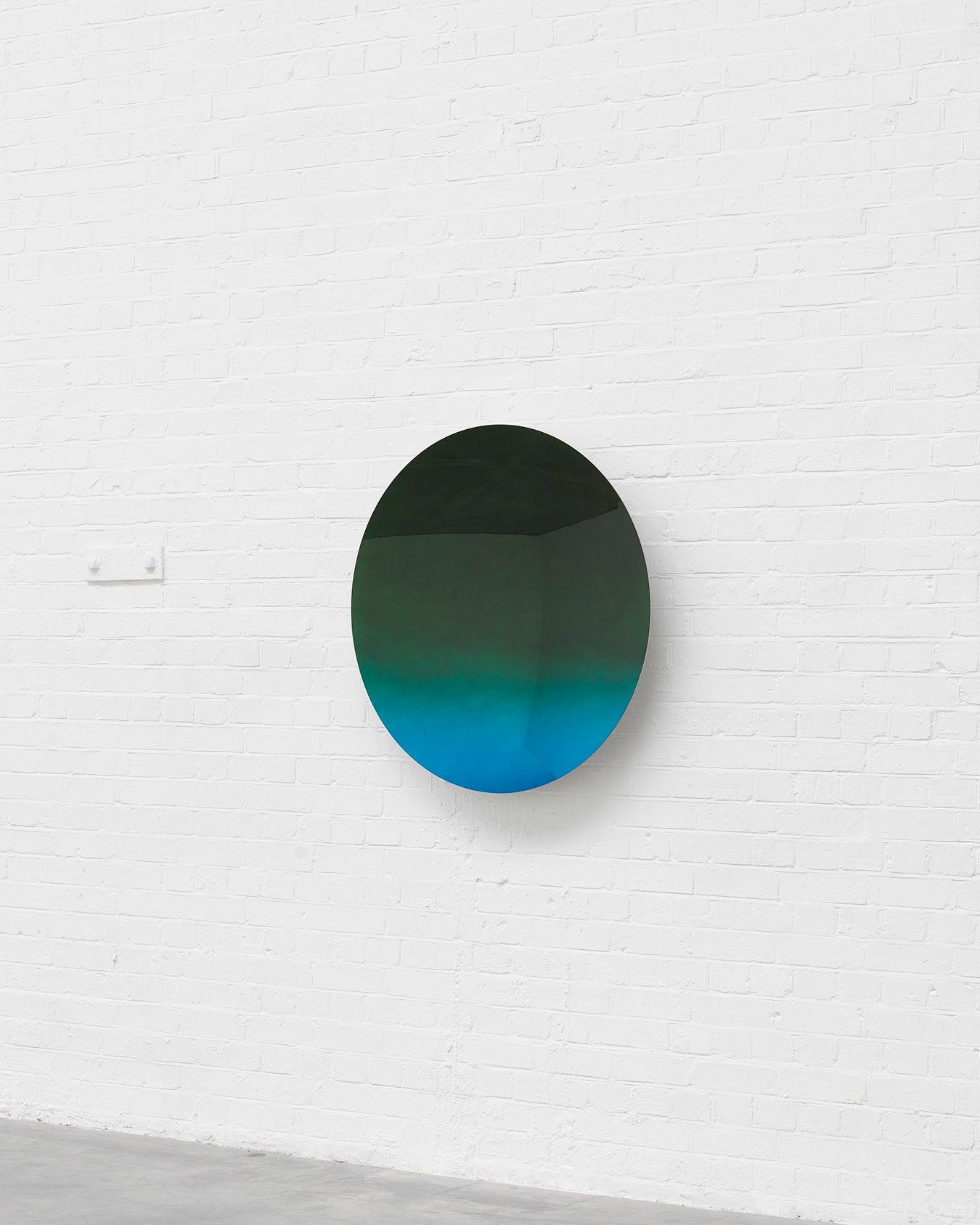
Anish Kapoor
Organic Green and Black to Oriental Blue
2023
Stainless steel, lacquer
35 3/8 x 35 3/8 x 4 inches (90 x 90 x 10 cm)
Organic Green and Black to Oriental Blue provides a particularly rich example of Anish Kapoor’s (b. 1954, Mumbai, India) celebrated series of mirror sculptures. Like many of Kapoor’s best-known works, Organic Green and Black to Oriental Blue heightens the viewer’s awareness of their physical and relational proximity to the art object by distorting the visual and auditory environment in unpredictable ways, provoking wonder, disbelief–– or even discomfort.
Alongside other projects, Kapoor’s mirror sculptures play a key role in his investigation into the space of painting. Rather than creating the illusion of a world beyond the flat surface of the picture plane—as linear perspective painting—these mirrors reflect and contort the space that the viewer physically occupies, turning the basic premise of painting inside out. By combining the formal tropes of minimalism with contemporary fabrication techniques, Kapoor creates sculptures that evoke the metaphysical dualities of presence and absence, meaning and nothingness, the material and the immaterial.
Kapoor’s work has been the subject of recent exhibitions at Casa Bradesco in the recently reopened Cidade Matarazzo, São Paulo (2024); The Liverpool Cathedral, where he presented works including the monumental Monadic Singularity (2024); ARKEN Museum of Modern Art, Ishøj (2024), Palazzo Strozzi, Florence (2023-2024), Skulpturenpark Waldfrieden, Wuppertal (2022–2023), Centre of Polish Sculpture, Orońsko (2022–2023), and a major two-part exhibition in Venice at the historic Gallerie dell'Accademia and the Palazzo Manfrin (2022).
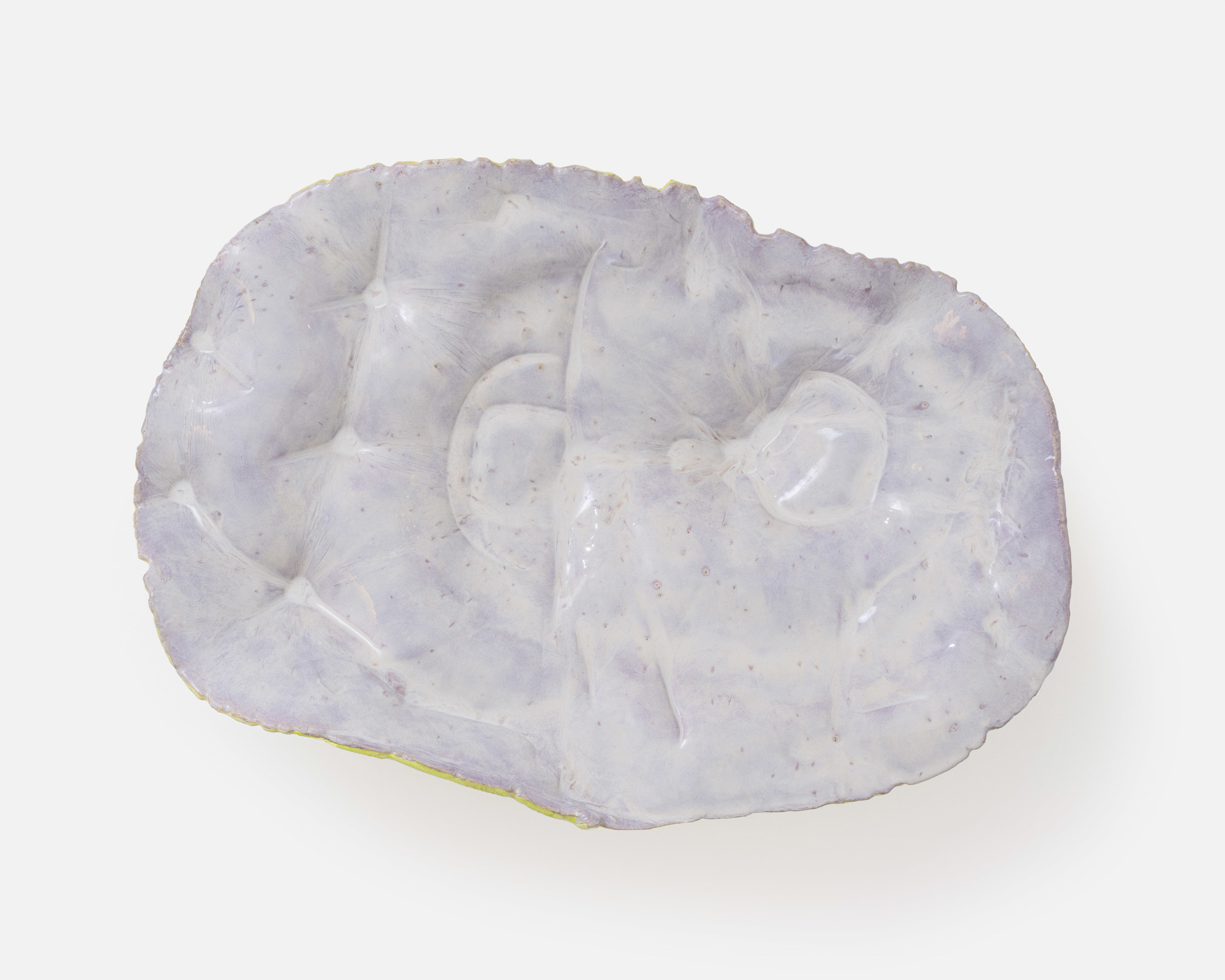
Liz Larner
Marshmallow Polypore
2024
Ceramic, glaze, aluminum, stainless steel, enamel paint
22 1/2 x 34 3/4 x 12 inches (57.2 x 88.3 x 30.5 cm)
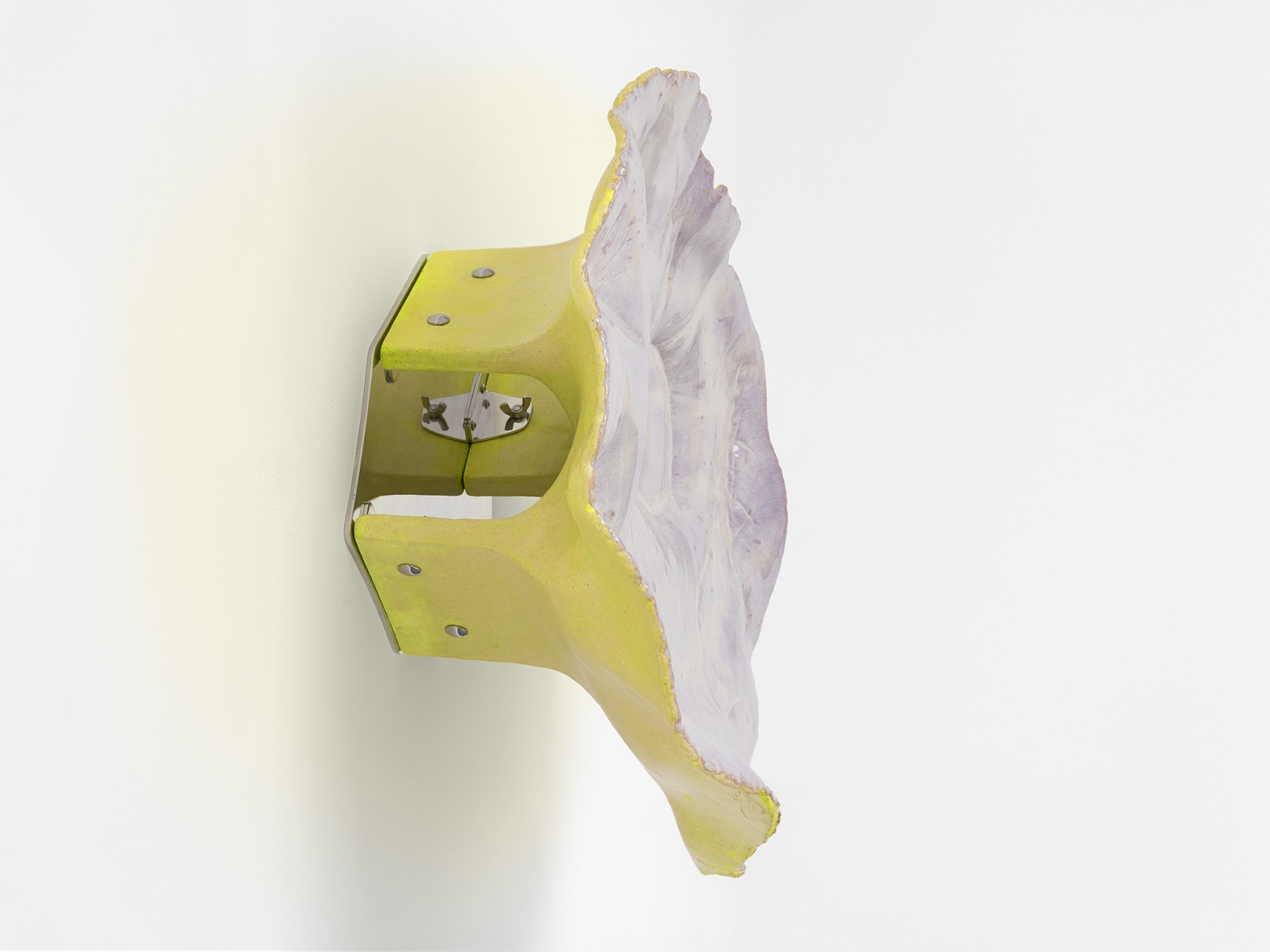
Liz Larner
Marshmallow Polypore
2024
Ceramic, glaze, aluminum, stainless steel, enamel paint
22 1/2 x 34 3/4 x 12 inches (57.2 x 88.3 x 30.5 cm)
Liz Larner’s ceramic slab sculptures evoke telluric interruptions from the geological depths, incorporating naturally occurring breaks, fissures, cracks, and bends. The ceramic forms support richly chromatic surfaces reminiscent of the earth's shifting crust. The resulting objects, hovering in front of the wall, are painterly and sculptural at once. Recently, Larner’s concerns have turned toward our shared ecology in the Anthropocene—our current era wherein human activity and intervention is the most dominant ecological force on the planet, shaping the course of rivers, moving entire mountains, and raising the ocean itself.
In her recent works, Larner continues to explore material and technique with her constantly evolving series of ceramic wall sculptures that showcase her mastery of glazing techniques and her continued interest in the transformative possibilities of sculpture. Recalling the organic biomorphism of her Herbal Remedy works (wall-mounted porcelain forms inspired by floral petals), these new works suggest the seemingly autonomous beauty and compositional patterns, colors, and textures of nature, where striking juxtapositions arise with both a sense of chance and mysterious order. In each, ceramic forms float off the wall in tandem with metallic mounts. Like two moods or artistic modes meeting, they present esoteric emblems, or perhaps a kind of sculpture that animates a wall—not unlike the way fine metalwork and jewelry might animate a profile or neckline. They juxtapose strikingly distinct surfaces and conceptual touchstones with the honed dexterity of curiosity as it meets experience.
Larner’s key role in the development of contemporary art has been recognized by numerous exhibitions, including two major presentations in 2022: Don’t put it back like it was, curated by Mary Ceruti for SculptureCenter, Long Island City, and Walker Art Center, Minneapolis, and below above at Kunsthalle Zürich. Past solo and two-person museum exhibitions include Liz Larner, Aspen Art Museum (2016); Liz Larner, Art Institute of Chicago (2015); Two or Three or Something: Maria Lassnig, Liz Larner, Kunsthaus Graz (2006); Liz Larner, Museum of Contemporary Art, Los Angeles (2001–2002); Liz Larner: I Thought I Saw a Pussycat, MAK – Museum of Applied Arts, Vienna (1998); and Liz Larner, Kunsthalle Basel (1997).
Liz Larner’s exhibition magnetic instinct is currently on view at Regen Projects through October 26, 2024.
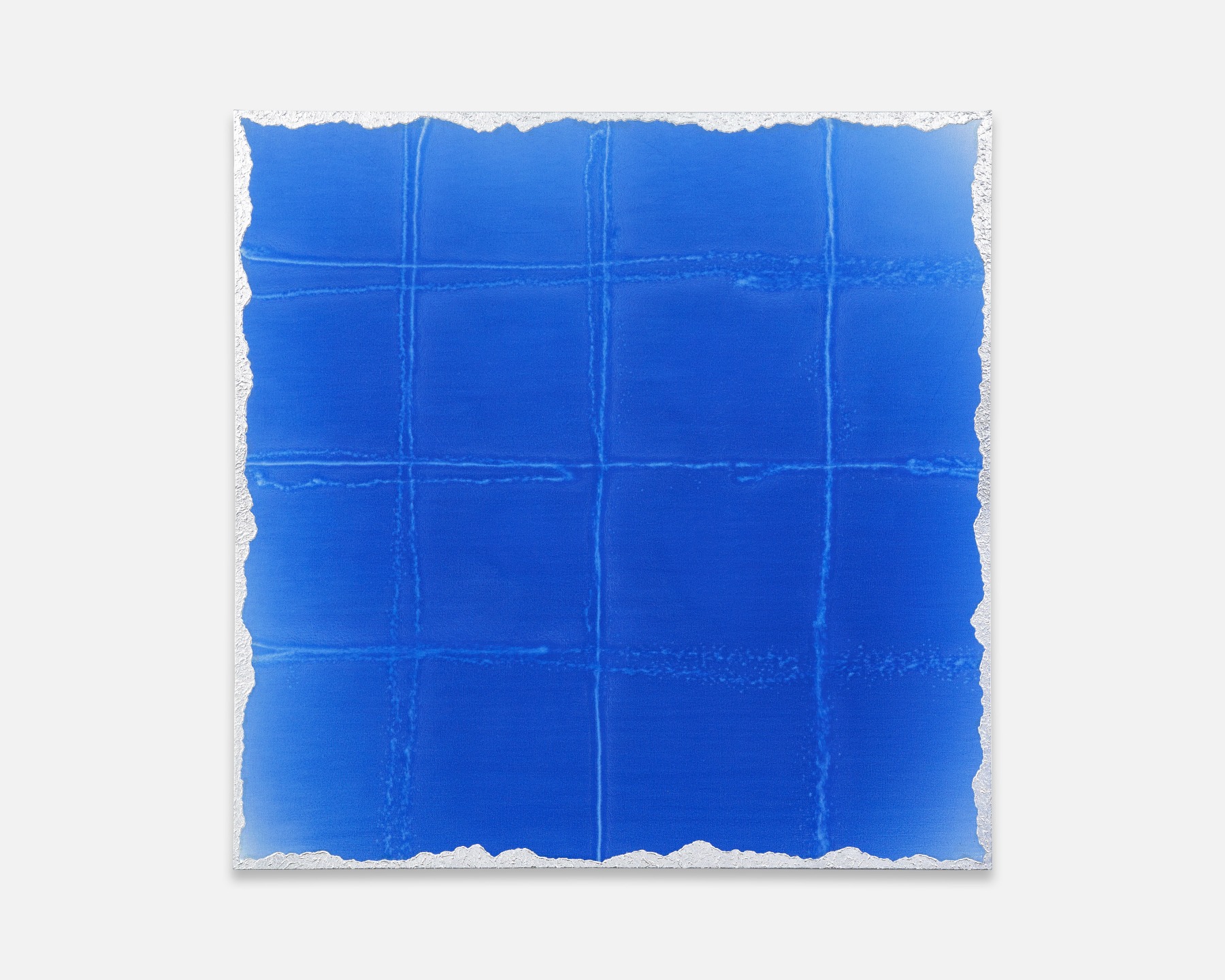
Rebecca Morris
Untitled (#15-24)
2024
Oil and spray paint on canvas
62 1/8 x 62 1/8 x 2 1/8 inches (157.8 x 157.8 x 5.4 cm)
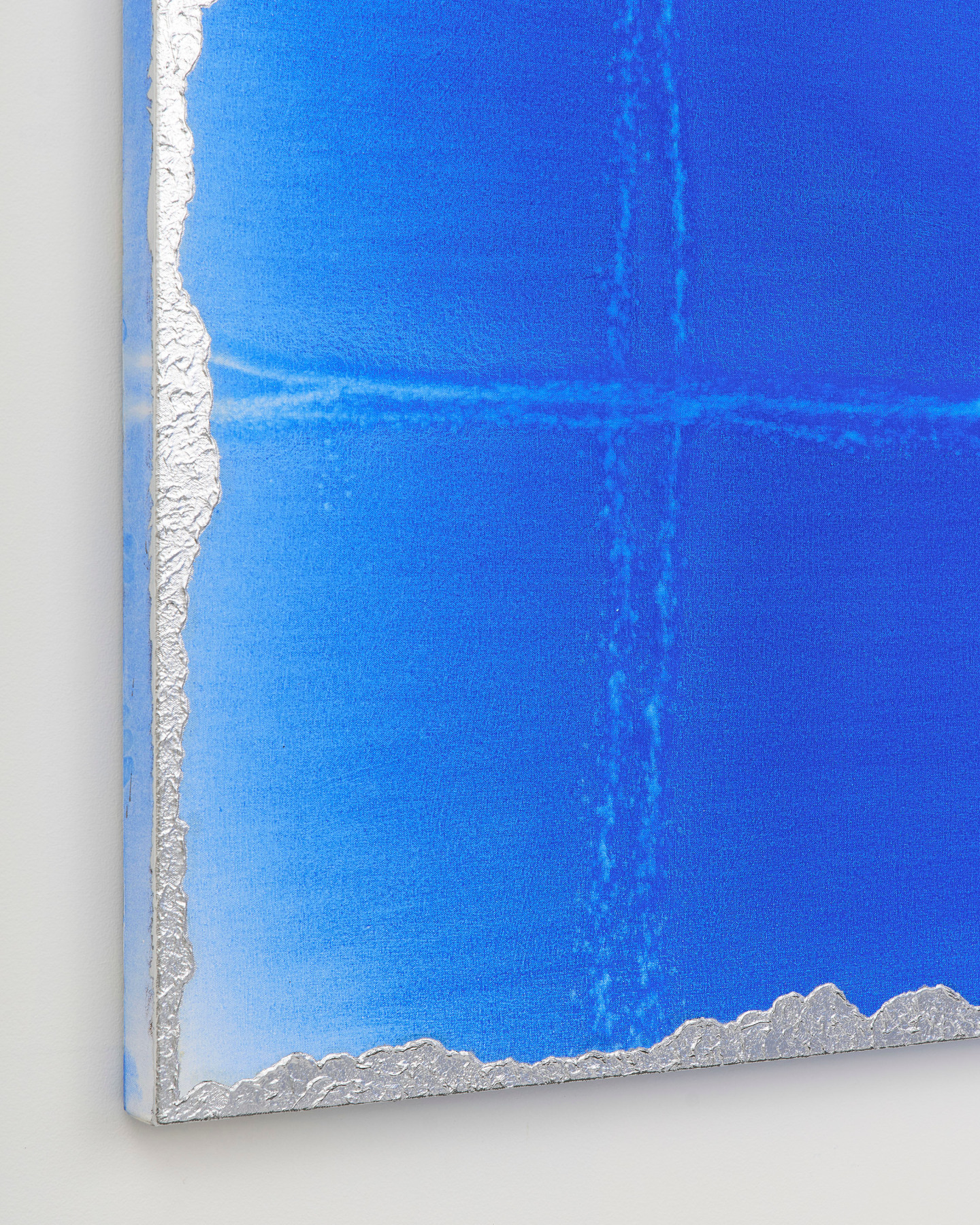
Rebecca Morris
Untitled (#15-24) [detail]
2024
Oil and spray paint on canvas
62 1/8 x 62 1/8 x 2 1/8 inches (157.8 x 157.8 x 5.4 cm)
Rebecca Morris (b. 1969, Honolulu, HI) has dedicated her thirty-year career to the exploration of abstraction. The Los-Angeles based painter deploys basic elements like mark, surface, and frame to dramatize the underlying tension between the flatness of the painted surface and its capacity to support visual illusions. Recurring motifs such as fragmented patterns and distorted grids further complicate her work against the larger history of conceptual artists that have used precise geometry to delineate visual space. Variously associated with the schools of Pattern and Decoration and Supports/Surfaces, Morris’s work has steadfastly refused placement into one clear category or movement.
Her 2004 “Manifesto (For Abstractionists and Friends of the Non-Objective),” placed as a full-page Artforum advertisement for an exhibition in Berlin, set forth her support of abstraction as a “campaign against the literal.”
Solo exhibitions of the artist’s work include Rebecca Morris: 2001–2022, Institute of Contemporary Art, Los Angeles (2022–2023), Museum of Contemporary Art Chicago (2023); Rebecca Morris: The Ache of Bright, Blaffer Art Museum, University of Houston (2019); Rose Cut, 356 Mission, Los Angeles (2015); Southafternoon, Kunsthalle Lingen (2013), Bonnefanten Museum, Maastricht (2014); Rebecca Morris: Fantastic L.A., LAXART, Los Angeles (2014); Rebecca Morris Paintings 1996–2005, The Renaissance Society at the University of Chicago (2005); and Rebecca Morris: Frankenstein, Santa Monica Museum of Art (2003). Morris’s work has been presented in numerous group exhibitions including Prospect 2017, Museum of Contemporary Art San Diego; Made in L.A. 2016: a, the, though, only, Hammer Museum; and Whitney Biennial 2014, Whitney Museum of American Art, New York, among others.
Morris will present her first exhibition with Regen Projects in 2025.
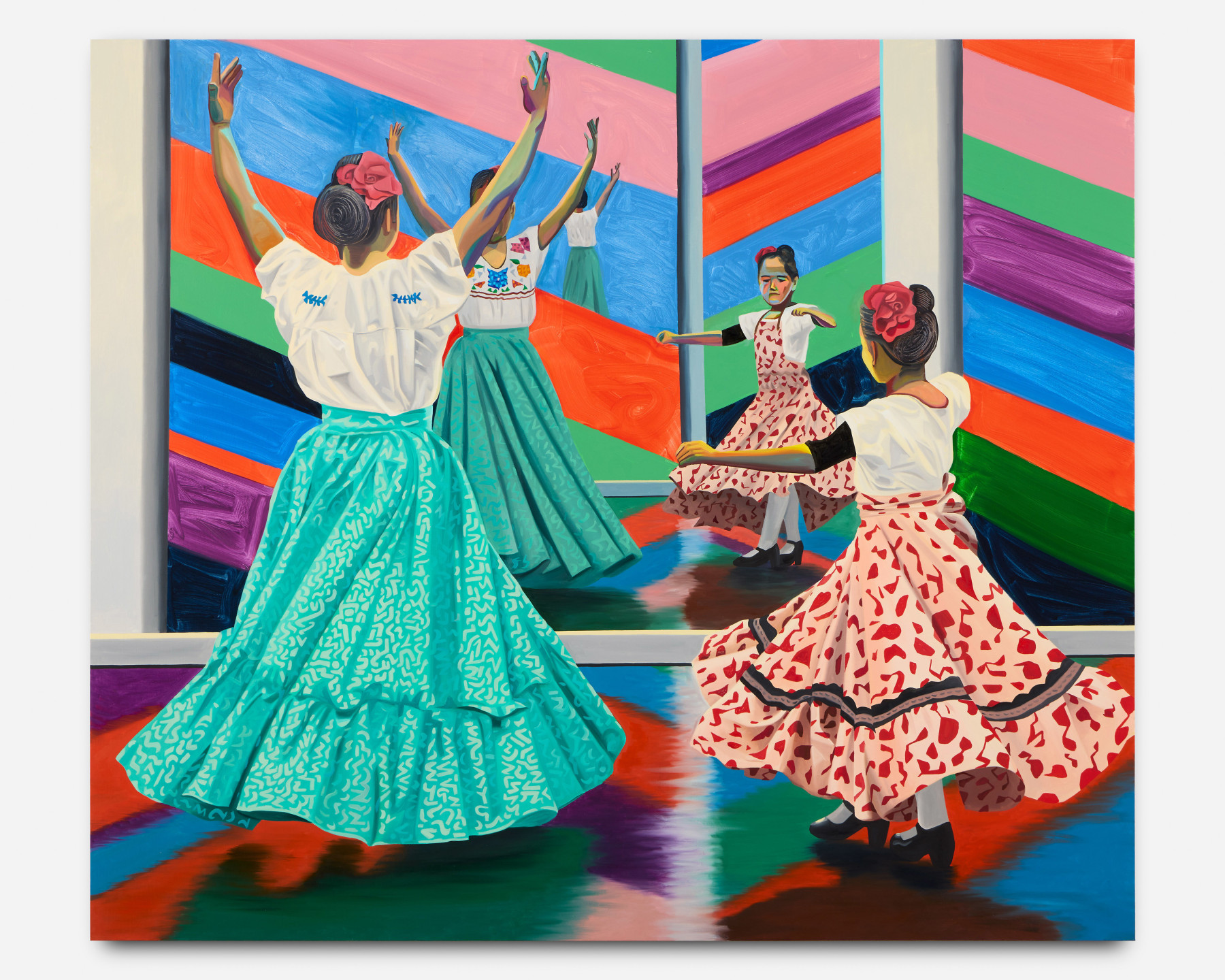
Aliza Nisenbaum
La Aprendiz
2024
Oil on linen
69 x 80 x 1 1/2 inches (175.3 x 203.2 x 3.8 cm)
Aliza Nisenbaum’s (b. 1977, Mexico City, Mexico) portraits emerge from prolonged, thoughtful exchanges between the artist and members of specific, carefully chosen communities: transportation and healthcare workers, immigrants, dancers, or grassroot organizers. By fostering connections and sharing skills and resources over extended periods of time, Nisenbaum develops an understanding of the identities, histories, and contexts that frame her subjects. As such, her practice expands—and even exceeds—the delimited space of a painted portrait. Lushly patterned with textures excerpted from the interiors of her sitter’s real homes and workplaces, Nisenbaum’s paintings illuminate the material conditions of their lives. The artist deploys a broad range of painterly techniques, applying continuous grounds with bold, broad brushstrokes; articulating a subject’s features with interlocking, Fauvist tracts of vivid color; or detailing, with naturalistic precision, the design of a tiled wall, a decorative blanket, or an embroidered blouse.
An early, leading figure in the centrality of representation and portraiture, Nisenbaum develops vibrant, figurative paintings through a form of participatory observation. She forges relationships with her subjects and connects meaningfully to the complex communities they create together. Informed by a diverse array of artistic and political traditions, Nisenbaum’s pictures (and the process through which they are made) recall forebears such as Alice Neel, Sylvia Sleigh, and Diego Rivera.
From mariachi to salsa, the works on view give painterly shape to the fleeting festivity of these traditions. Exploring connections between sight and sound, they evoke music and movement in an otherwise static, silent medium by way of color, contour, and pattern. As such, they recall modernist experiments and visionaries such as Sonia Delaunay and Florine Stettheimer. Mindful of the ever-intensifying specter of technology that shapes our daily lives and recalling sociologist Émile Durkheim’s theory of “collective effervescence,” Nisenbaum’s paintings celebrate these spaces and occasions for dancing as consecrated moments apart from our screens and devices, reminding us of the pleasure of being more fully of and with our bodies and each other.
Similarly, as dancers slide and screech to a halt, the undulating motion of the wooden floors mirrors the movement of the figures via painterly gesture. Rehearsal mirrors and elevated bars occasion playful angles, geometries, and juxtapositions, expanding and suturing spaces and passages. They punctuate, frame, divide, and at times provocatively double or even triple figures and forms, creating and implying pictures within pictures. Such reflections liken Nisenbaum’s activity as a painter to that of the whirling dancers. Her complex tableaux reveal her deep awareness and clear delight in the possibilities of painting to narrate human experience and the relationships that sustain us.
Selected solo and two-person exhibitions include The Metropolitan Opera, New York (2023–2024); Queens Museum, New York (2023); Delta Air Lines x Queens Museum at LaGuardia Airport, New York (2022); Kemper Museum of Contemporary Art, Kansas City (2022); Tate Liverpool (2020); Minneapolis Institute of Art (2017–2018); and University Galleries at Wonsook Kim College of Fine Arts, Illinois State University (2007).
Aliza Nisenbaum’s exhibition Altanera, Preciosa y Orgullosa is currently on view at Regen Projects through October 26, 2024.
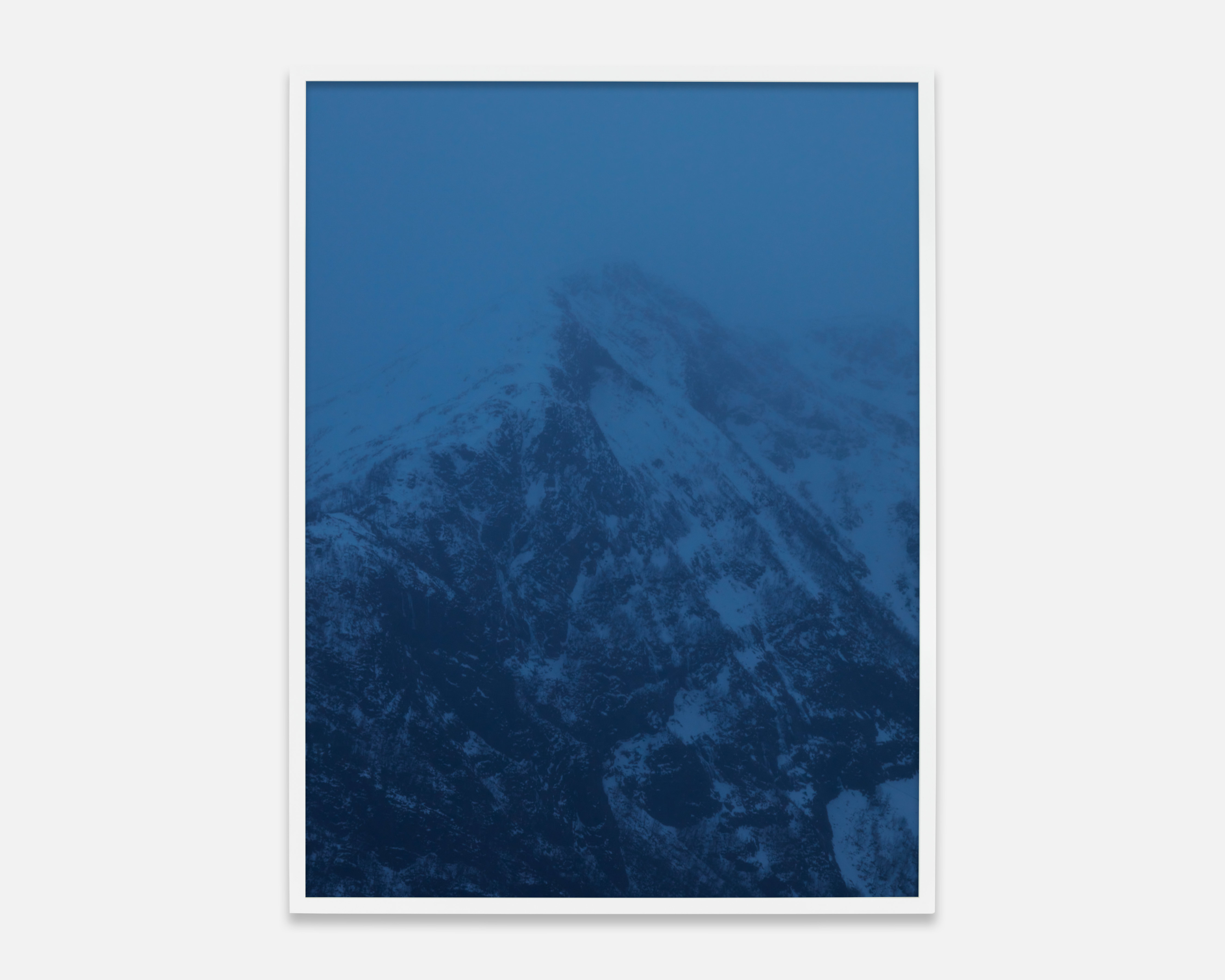
Catherine Opie
Untitled #4 (Norway Mountain)
2024
Pigment print
78 1/2 x 59 5/8 x 2 inches (199.4 x 151.4 x 5.1 cm)
Edition of 5, 2 AP
For over thirty years, Catherine Opie (b. 1961, Sandusky, OH) has captured both iconic and often overlooked aspects of contemporary life and culture. One of the most important photographers of her generation, her photographic subjects have included early portraits of the LGBTQ+ community, the architecture of Los Angeles’s freeway system, mansions in Beverly Hills, Midwestern icehouses, high school football players, California surfers, abstract landscapes of National Parks, and the Bel-Air residence of Elizabeth Taylor, among others. Her complex and diverse body of work is political, personal, and highly aesthetic, keeping questions of form, concept, and the documentary in constant dynamic interplay.
Opie’s recent series of Norway Mountain photographs were taken during her 2024 road trip through the Norwegian countryside in search of the “blue hour,” a phenomenon that only occurs during polar winter. Deeply in dialogue with the history of landscape imagery and the color blue, Opie’s photographs extend from her more than thirty year practice of closely observing the social and physical world around her. The work's vertical orientation reveals that Opie considers these images to be “portraits” of each mountain, addressing them as bodies that provide testament to the Earth’s unique individuality. Through her consideration of massive forms that change on geologic timescales, Opie confronts the scale of human history as well, and here provides another brilliant example of her expansive photographic practice.
Opie’s work has been the subject of recent solo exhibitions at Museum of Art São Paulo Assis Chateaubriand (2024); Heide Museum of Modern Art, Bulleen (2023); Museum of Contemporary Art Cleveland (2019); Henie Onstad Kunstsenter, Oslo (2017); Los Angeles County Museum of Art (2016 and 2010); Hammer Museum, Los Angeles (2016); MOCA Pacific Design Center, Los Angeles (2016); Wexner Center for the Arts, Columbus (2015); Walker Art Center, Minneapolis (2014); Institute of Contemporary Art, Boston (2011); Portland Art Museum (2010); Guggenheim Museum, New York (2008); Museum of Contemporary Art, Chicago (2006); Saint Louis Art Museum (2000); The Photographers’ Gallery, London (2000); Museum of Contemporary Art, Los Angeles (1997); among others. In 2016, Opie completed a monumental commission for the new Los Angeles Federal Courthouse.
For over thirty years, Catherine Opie (b. 1961, Sandusky, OH) has captured both iconic and often overlooked aspects of contemporary life and culture. One of the most important photographers of her generation, her photographic subjects have included early portraits of the LGBTQ+ community, the architecture of Los Angeles’s freeway system, mansions in Beverly Hills, Midwestern icehouses, high school football players, California surfers, abstract landscapes of National Parks, and the Bel-Air residence of Elizabeth Taylor, among others. Her complex and diverse body of work is political, personal, and highly aesthetic, keeping questions of form, concept, and the documentary in constant dynamic interplay.
Opie’s recent series of Norway Mountain photographs were taken during her 2024 road trip through the Norwegian countryside in search of the “blue hour,” a phenomenon that only occurs during polar winter. Deeply in dialogue with the history of landscape imagery and the color blue, Opie’s photographs extend from her more than thirty year practice of closely observing the social and physical world around her. The work's vertical orientation reveals that Opie considers these images to be “portraits” of each mountain, addressing them as bodies that provide testament to the Earth’s unique individuality. Through her consideration of massive forms that change on geologic timescales, Opie confronts the scale of human history as well, and here provides another brilliant example of her expansive photographic practice.
Opie’s work has been the subject of recent solo exhibitions at Museum of Art São Paulo Assis Chateaubriand (2024); Heide Museum of Modern Art, Bulleen (2023); Museum of Contemporary Art Cleveland (2019); Henie Onstad Kunstsenter, Oslo (2017); Los Angeles County Museum of Art (2016 and 2010); Hammer Museum, Los Angeles (2016); MOCA Pacific Design Center, Los Angeles (2016); Wexner Center for the Arts, Columbus (2015); Walker Art Center, Minneapolis (2014); Institute of Contemporary Art, Boston (2011); Portland Art Museum (2010); Guggenheim Museum, New York (2008); Museum of Contemporary Art, Chicago (2006); Saint Louis Art Museum (2000); The Photographers’ Gallery, London (2000); Museum of Contemporary Art, Los Angeles (1997); among others. In 2016, Opie completed a monumental commission for the new Los Angeles Federal Courthouse.
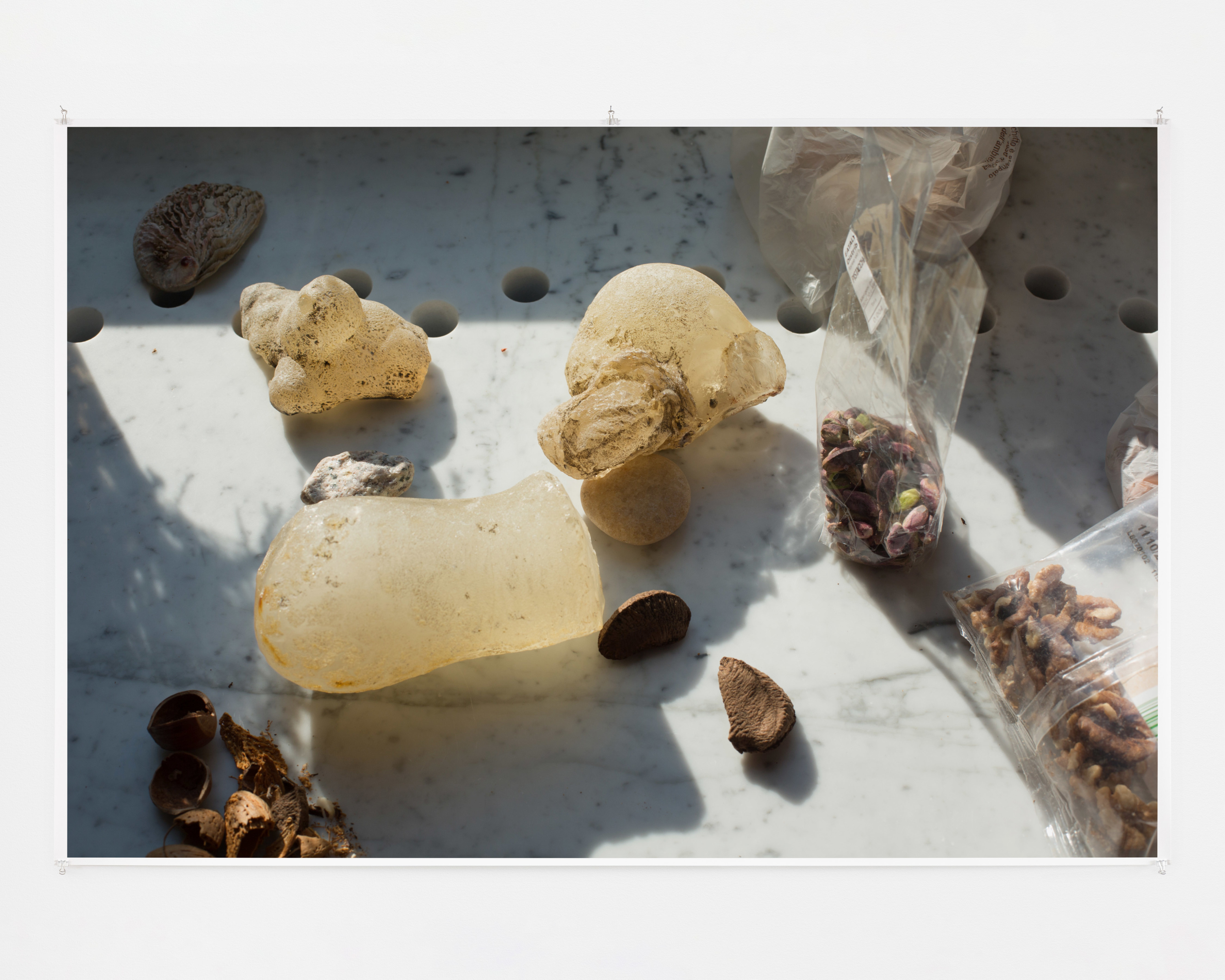
Wolfgang Tillmans
Still Life Kinshasa / Berlin
2018
Inkjet print on paper, clips
54 3/8 x 81 1/2 inches (138 x 207 cm)
Edition of 1, 1 AP
Wolfgang Tillmans’s photographs put the tender, exquisite, everyday, transient, and fortuitous into dialogue as he engages with the material and conceptual possibilities of the medium. His wide-ranging subjects and genres collectively showcase the artist’s unique perspective and his ability to use the many languages of photography to enunciate his trajectory through the world. Tillmans distills our fragmented, image-saturated moment into a subjective experience—capturing the political, personal, and aesthetic at once.
Tillmans has long engaged with still life as a genre, often capturing chance arrangements of objects tenderly placed upon a table or windowsill. His interest in the residual fragments of everyday life speaks to not only the fleeting moments of intimacy that can be captured and preserved, but also to the ways these objects are traces of his passage through the world.
In 2022, a major exhibition of Tillmans’s work entitled To look without fear opened at the Museum of Modern Art, New York, and traveled to the Art Gallery of Ontario and San Francisco Museum of Modern Art. Prior exhibitions include Fragile, a touring African survey organized by the Institut für Auslandsbeziehungen (2018–2022); Museum Moderner Kunst Stiftung Ludwig Wien (MUMOK), Vienna (2021); and WIELS Contemporary Art Centre, Brussels (2020).
Wolfgang Tillmans’s photographs put the tender, exquisite, everyday, transient, and fortuitous into dialogue as he engages with the material and conceptual possibilities of the medium. His wide-ranging subjects and genres collectively showcase the artist’s unique perspective and his ability to use the many languages of photography to enunciate his trajectory through the world. Tillmans distills our fragmented, image-saturated moment into a subjective experience—capturing the political, personal, and aesthetic at once.
Tillmans has long engaged with still life as a genre, often capturing chance arrangements of objects tenderly placed upon a table or windowsill. His interest in the residual fragments of everyday life speaks to not only the fleeting moments of intimacy that can be captured and preserved, but also to the ways these objects are traces of his passage through the world.
In 2022, a major exhibition of Tillmans’s work entitled To look without fear opened at the Museum of Modern Art, New York, and traveled to the Art Gallery of Ontario and San Francisco Museum of Modern Art. Prior exhibitions include Fragile, a touring African survey organized by the Institut für Auslandsbeziehungen (2018–2022); Museum Moderner Kunst Stiftung Ludwig Wien (MUMOK), Vienna (2021); and WIELS Contemporary Art Centre, Brussels (2020).
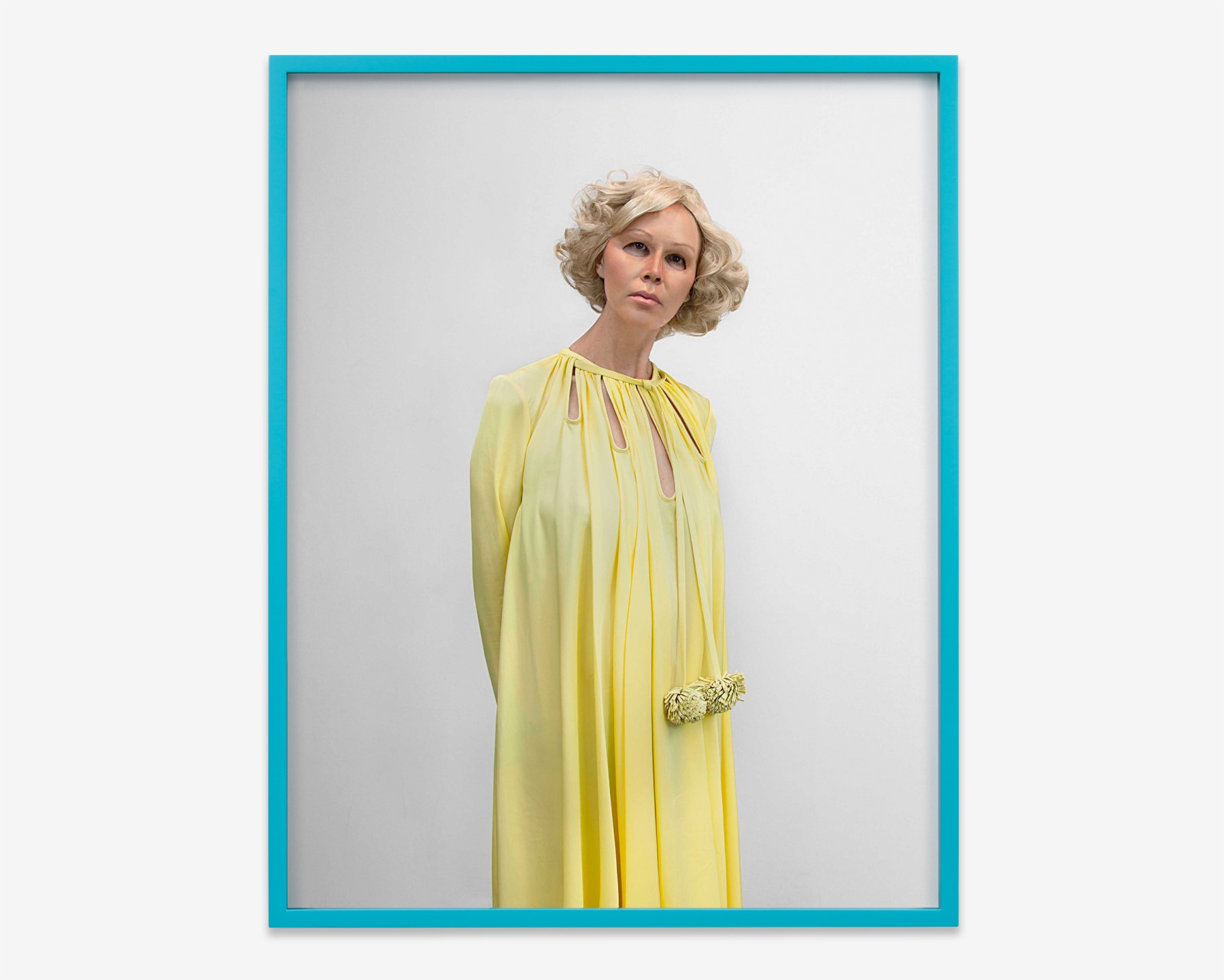
Gillian Wearing
Self Portrait (event)
2023
Framed c-type print
24 1/2 x 19 3/8 x 1 1/2 inches (62.2 x 49.2 x 3.8 cm)
Edition of 6, 2 AP
Over a career spanning three decades, Gillian Wearing has produced works in an array of media, including photography, video, sculpture, and painting, that question fixed notions of identity and test the boundaries between the self and the collective.
In this latest series, Wearing uses physical masks, AI, and Photoshop to transform herself into a succession of characters relaying her belief that a self-portrait is a controlled masquerade. Referencing the stars of Classical Hollywood, Wearing described “I wanted the characters to be actors rather than models, so some of the shots feel more performative [...] I wanted the photographs to initially not look like they are me in disguise. We can think of masks as being unnerving. I wanted them to look more human."
Wearing was recently the subject of Gillian Wearing: Wearing Masks, a major retrospective at the Solomon R. Guggenheim Museum, New York (2021–2022). Recent solo exhibitions include Life: Gillian Wearing, Cincinnati Art Museum (2018); Gillian Wearing – Family Stories, The National Gallery of Denmark, Copenhagen (2017); Gillian Wearing and Claude Cahun: Behind the mask, another mask, National Portrait Gallery, London (2017); Gillian Wearing, Institut Valencià d'Art Modern (2015); among others. Wearing was awarded the Turner Prize in 1997, elected a lifetime member of the Royal Academy of Arts in 2007, and appointed an OBE in 2011. She was awarded Commander of the Order of the British Empire in 2019.
Over a career spanning three decades, Gillian Wearing has produced works in an array of media, including photography, video, sculpture, and painting, that question fixed notions of identity and test the boundaries between the self and the collective.
In this latest series, Wearing uses physical masks, AI, and Photoshop to transform herself into a succession of characters relaying her belief that a self-portrait is a controlled masquerade. Referencing the stars of Classical Hollywood, Wearing described “I wanted the characters to be actors rather than models, so some of the shots feel more performative [...] I wanted the photographs to initially not look like they are me in disguise. We can think of masks as being unnerving. I wanted them to look more human."
Wearing was recently the subject of Gillian Wearing: Wearing Masks, a major retrospective at the Solomon R. Guggenheim Museum, New York (2021–2022). Recent solo exhibitions include Life: Gillian Wearing, Cincinnati Art Museum (2018); Gillian Wearing – Family Stories, The National Gallery of Denmark, Copenhagen (2017); Gillian Wearing and Claude Cahun: Behind the mask, another mask, National Portrait Gallery, London (2017); Gillian Wearing, Institut Valencià d'Art Modern (2015); among others. Wearing was awarded the Turner Prize in 1997, elected a lifetime member of the Royal Academy of Arts in 2007, and appointed an OBE in 2011. She was awarded Commander of the Order of the British Empire in 2019.
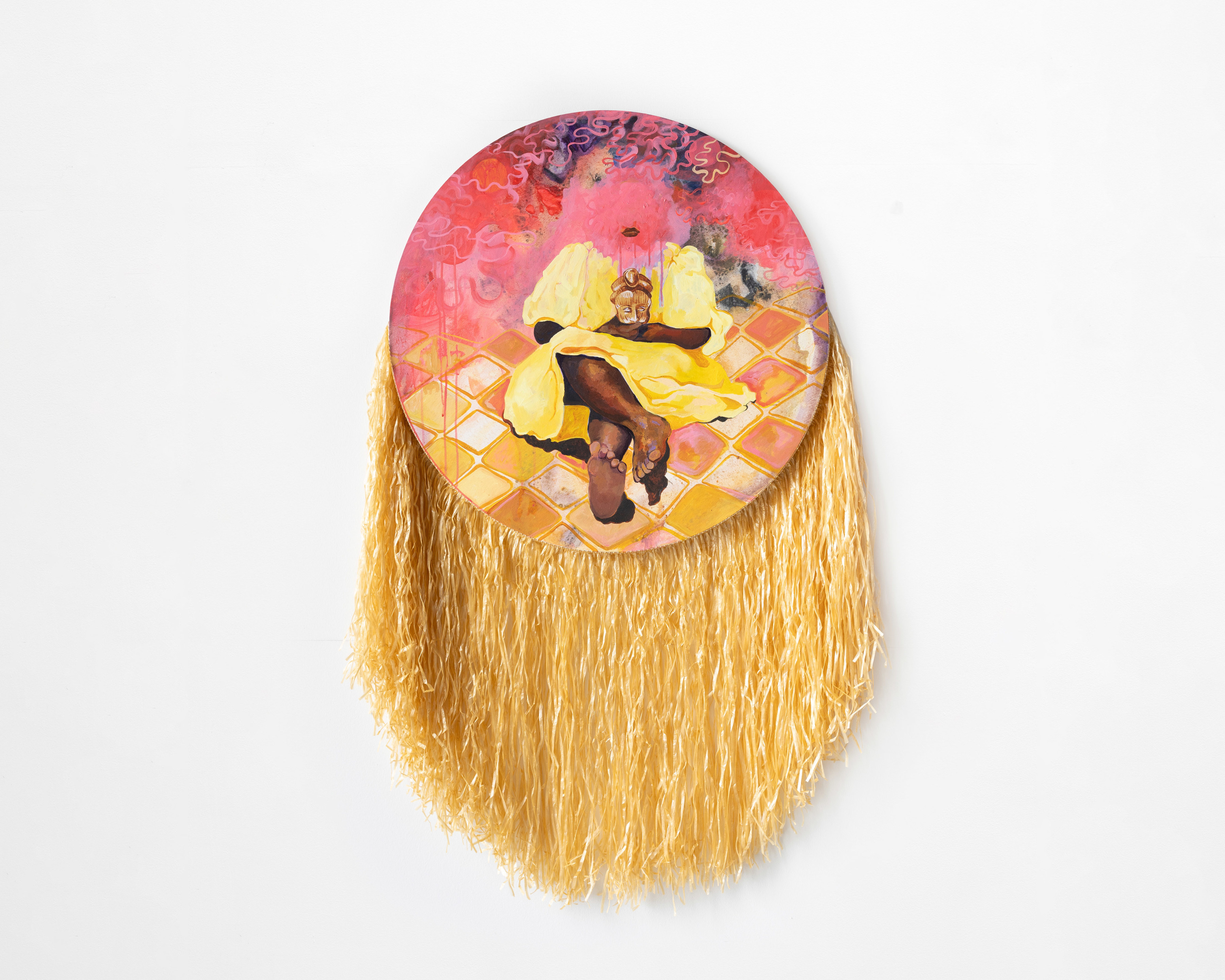
Alberta Whittle
Every element of the body wants to speak (Precious)
2024
Acrylic on canvas and raffia
57 1/2 x 39 x 2 3/8 inches (146 x 99 x 6 cm)
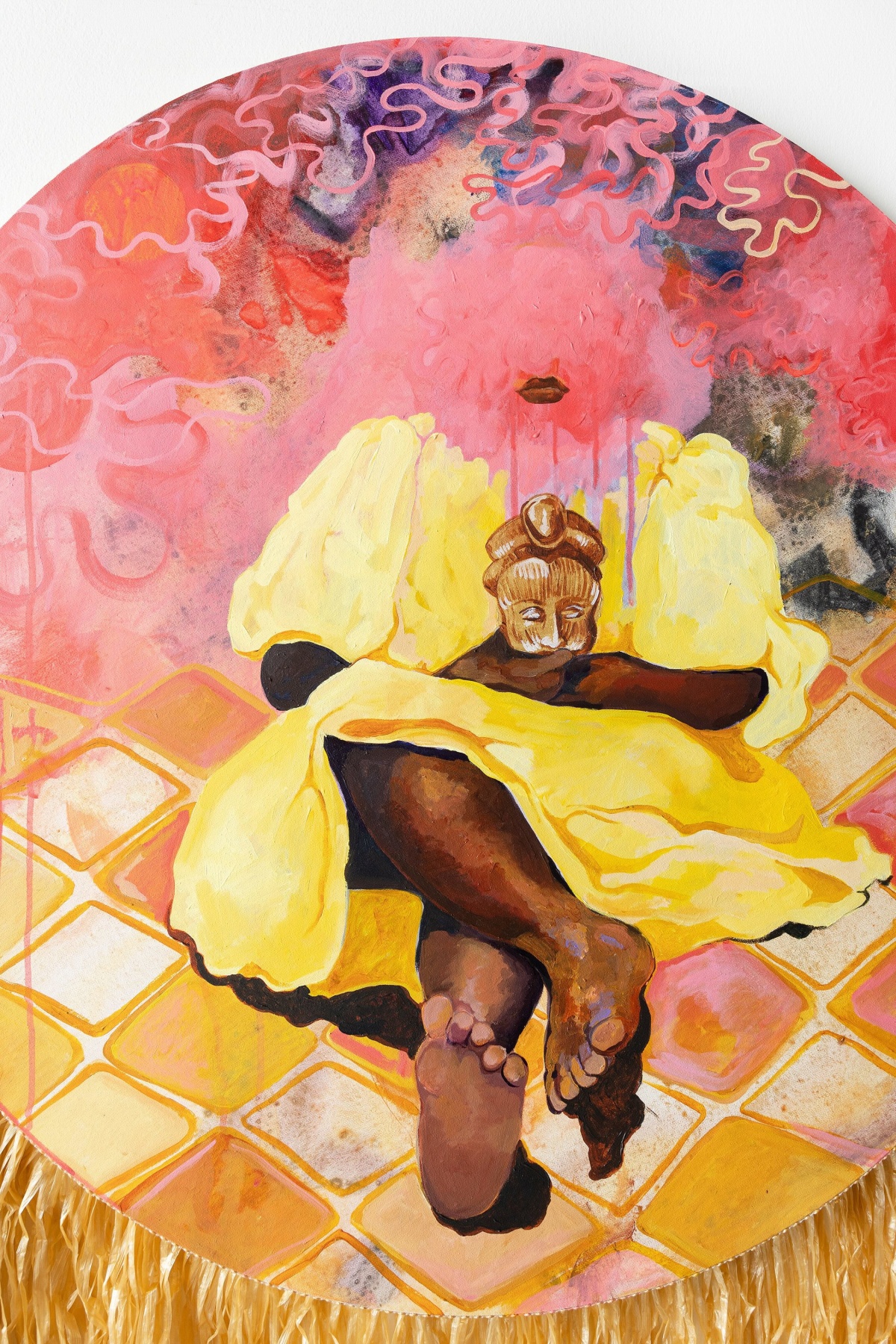
Alberta Whittle
Every element of the body wants to speak (Precious) [detail]
2024
Acrylic on canvas and raffia
57 1/2 x 39 x 2 3/8 inches (146 x 99 x 6 cm)
Alberta Whittle’s (b. 1980, Bridgetown, Barbados) creative practice is motivated by the desire to manifest self-compassion and collective care as key methods in battling anti-Blackness. Her multi-media practice encompasses drawing, digital collage, film, sculpture, performance, and writing, through which she develops a visual, oral, and textual language that questions accepted Western constructs of history and society. Her public presentations are often choreographed as interactive installations, that speak to the site in which they are being presented and prioritize questions of self-care and compassion, while considering the historic legacies and contemporary expressions of anti-Blackness, colonialism, and migration.
This work is from Whittle’s series of tondos (round works) and depicts Whittle’s friend Blessing Amos aka Precious seated on a tiled floor with her face veiled by the same colorful mists that comprise the background. As Whittle explains of her tondos, they “are meant to feel like portals. In fact, this idea of a portal as a space of transcendence and really thinking about what we are moving through, you know, how we can find ourselves in another space to rethink ideas, is very important in my work.”
Whittle’s extensive range of exhibitions includes solo presentations at Mount Stuart, Scotland (2024); the Institute of Contemporary Art, Philadelphia (2024, with Dominique White); Institute of Contemporary Art, Los Angeles (2023); Scottish National Gallery of Modern Art, Edinburgh (2023); Holburne Museum, Bath (2023); Scotland + Venice, 59th Venice Biennale (2022); University of Johannesburg Gallery, Johannesburg (2021); Jupiter Artland, Edinburgh (2021); Glasgow International (2021); Grand Union, Birmingham (2020); and Dundee Contemporary Arts (2019). Selected group exhibitions include Soulscapes, Dulwich Picture Gallery, London (2024); Black Atlantic: Power, People, Resistance, The Fitzwilliam Museum, Cambridge (2023); Soft and weak like water, 14th Gwangju Biennale, Gwangju (2023); British Art Show 9 (2021-2022); Moving Bodies, Moving Images, Whitechapel Gallery, London (2022); Black Melancholia, CCS Bard Hessel Museum of Art, Annandale-on-Hudson (2022); Sex Ecologies, Kunsthall Trondheim, Norway (2021); and Life between islands: Caribbean British Art 1950s – Now, Tate Britain, London (2021).